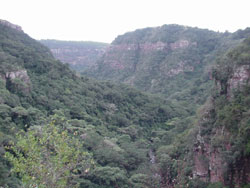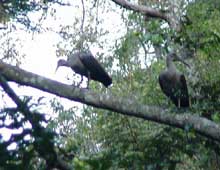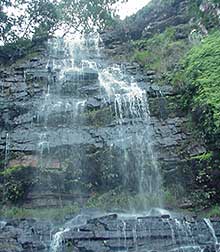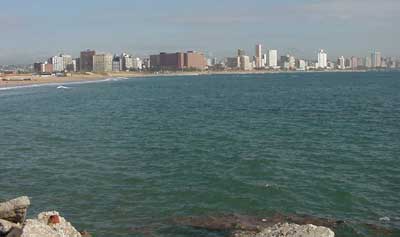|

|
South Africa Mission Log Include
|
|
|
|
|
Traveling to the Krantz Kloof Reserve
By Elizabeth Moore

The Krantz Kloof Gorge. |
April 17—The delegation traveled to the Krantz Kloof Reserve (Afrikaans for “cliff” and “gorge” respectively) today to continue discussions with our hosts. On the way, we stopped to see the Durban harbor waterfront (the busiest port in Africa) and were treated to the sight of a pilot being lifted by helicopter sling from an outgoing container ship to an incoming vessel (apparently their normal mode of transporting pilots from ship to ship). We continued on to the Reserve’s Interpretive Center.
At the center, Liz Moore gave a presentation on management plans and the (National Marine Sanctuary Program’s (NMSP) management plan review process. Carol Bernthal followed with a presentation of the accomplishments and challenges of managing MPA. Bob Currel discussed enforcement programs in the Florida Keys National Marine Sanctuary, and Francesca Cava presented her thoughts about the importance of education and outreach programs in MPAs. Each presentation was followed by discussion with our South African colleagues, most of which focused on the applicability of NMSP methods and experience to the proposed Aliwal Shoal Marine Protected Area and its context.

African ibis in the Reserve. |
We ended our third day in South Africa with a hike on one of the trails of the Reserve, where we saw the cliffs and gorges for which the Reserve is named, and several gorgeous waterfalls. Highlights included a crowned eagles nest, (these eagles are known for their predation on monkeys), hyrax or “rock rabbit”, a troop of vervet monkeys scampering along a steep cliff, and a medicine plant that our African colleagues say contains cortisone. The contrast between the serenity of the reserves and the surrounding homes and busy road was very striking.
April 18—We returned to the Krantz Kloof Reserve today to continue our presentations and discussions. We began the day with a presentation by Lad Atkins on diving, research, and volunteer programs for MPAs, followed by Becky Shortland’s thoughts on Sanctuary Advisory Councils and other methods of public involvement in MPA decision-making. Ted Beuttler’s discussion about the legal infrastructure that supports the National Marine Sanctuaries concluded the presentations. Our colleagues expressed significant interest in the use of both volunteers and of Sanctuary Advisory Councils.

Waterfall in the Krantz Kloof Reserve. |
The afternoon was spent in preparing for the work ahead. The discussion revealed a number of significant differences in the way each country designates its MPAs and how it prepares its management plans. Here in South Africa, they are working with fewer legal obligations, far fewer resources, and in a much shorter time frame than we do in the U.S. It is clear we have a challenging task ahead of us to complete a management plan in such a short time that will both meet the needs of KwaZulu/Natal Wildlife and achieve the task of creating a new kind of MPA management plan for South Africa. To help accomplish this imposing task, the American delegation and our South African colleagues were divided into a series of working groups that will be responsible for preparing different sections of the management plan. These working groups will begin their work next week, following a second visit to Aliwal Shoal this weekend to see the site and continue our visits with user groups in the local community.
Soon we headed for a second hike on a different trail at the Reserve. This time we hiked in forested land and stood at the base of a magnificent waterfall spilling down over sandstone cliffs with luxuriant ferns and small trees. This time we saw African ibis and rock rabbits or hyrax.
We have been in Durban almost a week now, and though it is a vibrant city with a lovely beach, I have sometimes felt as though we were in Miami or any other large coastal city in the world. With the visits to Krantz Kloof and its beautiful trails and wildlife, I finally feel as though I am in Africa. Seeing the ibis today that flushed off the path and into a tree as we hiked, and the family of three rock rabbits perched patiently on logs beyond the path thrilled me and served as a promise of the life we will see in the weeks to come, birds and animals that most people will only see in books or zoos.

Durban Waterfront. |
|
|











